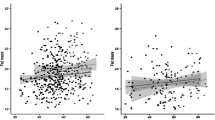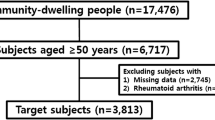Abstract
As little is known about the associations between body composition (fat mass and lean mass) and knee OA, especially regarding body parts (upper body and lower limbs), the purpose of this study was to identify the association between the former and the prevalence of the latter according to body parts. This study was designed as a cross-sectional analysis, with 4194 people (1801 men and 2393 women) from the fifth Korean National Health and Nutrition Examination Survey (KNHANES V, 2010–2011) included. Body composition (fat mass and lean mass) was measured by using dual-energy X-ray absorptiometry, and knee OA was diagnosed based on the level of Kellgren–Lawrence grade. In multivariate logistic regression analysis, upper body composition was not significantly correlated with radiographic knee OA (P > 0.05), while participants with higher lean mass of lower limbs were less likely to have radiographic knee OA (aOR 0.57; 95 % CI 0.32–0.99). In stratified analysis, participants with higher lean mass of lower limbs were less likely to have a radiographic knee OA in 40–54 kg (P for trend = 0.05) and 55–70 kg stratum (P for trend = 0.03), while this trend slightly attenuated in 70–85 kg stratum (P for trend = 0.15). In conclusion, the increase in lean mass of lower limbs is inversely related to the prevalence of knee OA while upper body composition is not. This study suggests that the lean mass of lower limbs might be associated with reduction in the risk of knee OA.

Similar content being viewed by others
References
Bartels EM, Juhl CB, Christensen R, Hagen KB, Danneskiold-Samsoe B, Dagfinrud H, Lund H (2016) Aquatic exercise for the treatment of knee and hip osteoarthritis. Cochrane Database Syst Rev 3:CD005523. doi:10.1002/14651858.CD005523.pub3
Brandt KD, Dieppe P, Radin E (2009) Etiopathogenesis of osteoarthritis. Med Clin North Am 93(1):1–24. doi:10.1016/j.mcna.2008.08.009 xv
Srikanth VK, Fryer JL, Zhai G, Winzenberg TM, Hosmer D, Jones G (2005) A meta-analysis of sex differences prevalence, incidence and severity of osteoarthritis. Osteoarthr Cartil 13(9):769–781. doi:10.1016/j.joca.2005.04.014
Kim MY, Park JK, Koh SB, Kim CB (2010) Factors influencing utilization of medical care among osteoarthritis patients in Korea: using 2005 Korean National Health and Nutrition Survey data. J Prev Med Public Health 43(6):513–522. doi:10.3961/jpmph.2010.43.6.513
Hur NW, Choi CB, Uhm WS, Bae SC (2008) The prevalence and trend of arthritis in Korea: results from Korea national health and nutrition examination surveys. J Rheum Dis 15(1):11–28
Cross M, Smith E, Hoy D, Nolte S, Ackerman I, Fransen M, Bridgett L, Williams S, Guillemin F, Hill CL, Laslett LL, Jones G, Cicuttini F, Osborne R, Vos T, Buchbinder R, Woolf A, March L (2014) The global burden of hip and knee osteoarthritis: estimates from the global burden of disease 2010 study. Ann Rheum Dis 73(7):1323–1330. doi:10.1136/annrheumdis-2013-204763
Ho-Pham LT, Lai TQ, Mai LD, Doan MC, Nguyen TV (2016) Body composition in individuals with asymptomatic osteoarthritis of the knee. Calcif Tissue Int 98(2):165–171. doi:10.1007/s00223-015-0080-8
Felson DT, Goggins J, Niu J, Zhang Y, Hunter DJ (2004) The effect of body weight on progression of knee osteoarthritis is dependent on alignment. Arthritis Rheum 50(12):3904–3909. doi:10.1002/art.20726
Manninen P, Riihimaki H, Heliovaara M, Makela P (1996) Overweight, gender and knee osteoarthritis. Int J Obes Relat Metab Disord 20(6):595–597
Spector TD, Hart DJ, Doyle DV (1994) Incidence and progression of osteoarthritis in women with unilateral knee disease in the general population: the effect of obesity. Ann Rheum Dis 53(9):565–568
Shin D, Kim S, Kim KH, Park SM (2014) Importance of fat mass and lean mass on bone health in men: the Fourth Korean National Health and Nutrition Examination Survey (KNHANES IV). Osteoporos Int 25(2):467–474. doi:10.1007/s00198-013-2412-8
Karlsson MK, Magnusson H, Coster M, Karlsson C, Rosengren BE (2015) Patients with knee osteoarthritis have a phenotype with higher bone mass, higher fat mass, and lower lean body mass. Clin Orthop Relat Res 473(1):258–264. doi:10.1007/s11999-014-3973-3
Karlsson MK, Magnusson H, von Schewelov T, Coster M, Karlsson C, Rosengren BE (2014) Patients with osteoarthritis in all three knee compartments and patients with medial knee osteoarthritis have a phenotype with high bone mass and high fat mass but proportionally low lean mass. Open Orthop J 8:390–396. doi:10.2174/1874325001408010390
Madsen OR, Brot C, Petersen MM, Sorensen OH (1997) Body composition and muscle strength in women scheduled for a knee or hip replacement. A comparative study of two groups of osteoarthritic women. Clin Rheumatol 16(1):39–44
Segal NA, Findlay C, Wang K, Torner JC, Nevitt MC (2012) The longitudinal relationship between thigh muscle mass and the development of knee osteoarthritis. Osteoarthr Cartil 20(12):1534–1540. doi:10.1016/j.joca.2012.08.019
von Schewelov T, Magnusson H, Coster M, Karlsson C, Rosengren BE (2015) Osteoarthritis of the distal interphalangeal and first carpometacarpal joints is associated with high bone mass in women and small bone size and low lean mass in men. Open Orthop J 9:399–404. doi:10.2174/1874325001509010399
Young CM (2012) Validity and reliability of korean version of international physical activity questionnaire short form in the elderly. Korean J Fam Med 33(3):144–151. doi:10.4082/kjfm.2012.33.3.144
Kellgren JH, Lawrence JS (1957) Radiological assessment of osteo-arthrosis. Ann Rheum Dis 16(4):494–502
Shin D (2014) Association between metabolic syndrome, radiographic knee osteoarthritis, and intensity of knee pain: results of a national survey. J Clin Endocrinol Metab 99(9):3177–3183. doi:10.1210/jc.2014-1043
Han HS, Lee JY, Kang SB, Chang CB (2016) The relationship between the presence of depressive symptoms and the severity of self-reported knee pain in the middle aged and elderly. Knee Surg Sports Traumatol Arthrosc 24(5):1634–1642. doi:10.1007/s00167-015-3628-2
Association for the Study of Obesity and the International Obesity Task Force, World Health Organization (Western Pacific Region) (2000) The Asian-Pacific perspective: redefining obesity and its treatment. Health Communications Australia Pty Limited, Sydney
Hart DJ, Doyle DV, Spector TD (1995) Association between metabolic factors and knee osteoarthritis in women: the Chingford Study. J Rheumatol 22(6):1118–1123
Kofler T, Bossard M, Aeschbacher S, Tabord A, Repilado R, Javier F, van der Lely S, Berger S, Risch M, Risch L, Conen D (2016) The interrelationships of birthweight, inflammation and body composition in healthy adults. Eur J Clin Invest 46(4):342–348. doi:10.1111/eci.12606
Lang TF (2011) The bone-muscle relationship in men and women. J Osteoporos 2011:702735. doi:10.4061/2011/702735
Abbate LM, Stevens J, Schwartz TA, Renner JB, Helmick CG, Jordan JM (2006) Anthropometric measures, body composition, body fat distribution, and knee osteoarthritis in women. Obesity 14(7):1274–1281. doi:10.1038/oby.2006.145
Kensara OA, Wootton SA, Phillips DI, Patel M, Jackson AA, Elia M, Hertfordshire Study G (2005) Fetal programming of body composition: relation between birth weight and body composition measured with dual-energy X-ray absorptiometry and anthropometric methods in older Englishmen. Am J Clin Nutr 82(5):980–987
Uceyler N, Schafers M, Sommer C (2009) Mode of action of cytokines on nociceptive neurons. Exp Brain Res 196(1):67–78. doi:10.1007/s00221-009-1755-z
Stannus OP, Jones G, Blizzard L, Cicuttini FM, Ding C (2013) Associations between serum levels of inflammatory markers and change in knee pain over 5 years in older adults: a prospective cohort study. Ann Rheum Dis 72(4):535–540. doi:10.1136/annrheumdis-2011-201047
Andratsch M, Mair N, Constantin CE, Scherbakov N, Benetti C, Quarta S, Vogl C, Sailer CA, Uceyler N, Brockhaus J, Martini R, Sommer C, Zeilhofer HU, Muller W, Kuner R, Davis JB, Rose-John S, Kress M (2009) A key role for gp130 expressed on peripheral sensory nerves in pathological pain. J Neurosci 29(43):13473–13483. doi:10.1523/JNEUROSCI.1822-09.2009
Montgomery MM, Shultz SJ, Schmitz RJ, Wideman L, Henson RA (2012) Influence of lean body mass and strength on landing energetics. Med Sci Sports Exerc 44(12):2376–2383. doi:10.1249/MSS.0b013e318268fb2d
Thorlund JB, Aagaard P, Roos EM (2012) Muscle strength and functional performance in patients at high risk of knee osteoarthritis: a follow-up study. Knee Surg Sports Traumatol Arthrosc 20(6):1110–1117. doi:10.1007/s00167-011-1719-2
Cicuttini FM, Baker JR, Spector TD (1996) The association of obesity with osteoarthritis of the hand and knee in women: a twin study. J Rheumatol 23(7):1221–1226
Coster MC, Rosengren BE, Karlsson C, von Schevelow T, Magnusson H, Brudin L, Karlsson MK (2014) Bone mass and anthropometry in patients with osteoarthritis of the foot and ankle. Foot Ankle Surg 20(1):52–56. doi:10.1016/j.fas.2013.10.008
Jarvholm B, Lewold S, Malchau H, Vingard E (2005) Age, bodyweight, smoking habits and the risk of severe osteoarthritis in the hip and knee in men. Eur J Epidemiol 20(6):537–542
Reijman M, Pols HA, Bergink AP, Hazes JM, Belo JN, Lievense AM, Bierma-Zeinstra SM (2007) Body mass index associated with onset and progression of osteoarthritis of the knee but not of the hip: the Rotterdam Study. Ann Rheum Dis 66(2):158–162. doi:10.1136/ard.2006.053538
Karlsson MK, Magnusson H, Coster MC, Vonschewelov T, Karlsson C, Rosengren BE (2014) Patients with hip osteoarthritis have a phenotype with high bone mass and low lean body mass. Clin Orthop Relat Res 472(4):1224–1229. doi:10.1007/s11999-013-3395-7
Shanb AA, Youssef EF (2014) The impact of adding weight-bearing exercise versus nonweight bearing programs to the medical treatment of elderly patients with osteoporosis. J Fam Commun Med 21(3):176–181. doi:10.4103/2230-8229.142972
Shimomura K, Murase N, Osada T, Kime R, Anjo M, Esaki K, Shiroishi K, Hamaoka T, Katsumura T (2009) A study of passive weight-bearing lower limb exercise effects on local muscles and whole body oxidative metabolism: a comparison with simulated horse riding, bicycle, and walking exercise. Dyn Med 8:4. doi:10.1186/1476-5918-8-4
Escalante Y, Saavedra JM, Garcia-Hermoso A, Silva AJ, Barbosa TM (2010) Physical exercise and reduction of pain in adults with lower limb osteoarthritis: a systematic review. J Back Musculoskelet Rehabil 23(4):175–186. doi:10.3233/BMR-2010-0267
Fransen M, McConnell S (2008) Exercise for osteoarthritis of the knee. Cochrane Database Syst Rev 4:CD004376. doi:10.1002/14651858.CD004376.pub2
Maurer BT, Stern AG, Kinossian B, Cook KD, Schumacher HR Jr (1999) Osteoarthritis of the knee: isokinetic quadriceps exercise versus an educational intervention. Arch Phys Med Rehabil 80(10):1293–1299
Fransen M, McConnell S, Harmer AR, Van der Esch M, Simic M, Bennell KL (2015) Exercise for osteoarthritis of the knee. Cochrane Database Syst Rev 1:CD004376. doi:10.1002/14651858.CD004376.pub3
Alnahdi AH, Zeni JA, Snyder-Mackler L (2012) Muscle impairments in patients with knee osteoarthritis. Sports Health 4(4):284–292. doi:10.1177/1941738112445726
Liikavainio T, Lyytinen T, Tyrvainen E, Sipila S, Arokoski JP (2008) Physical function and properties of quadriceps femoris muscle in men with knee osteoarthritis. Arch Phys Med Rehabil 89(11):2185–2194. doi:10.1016/j.apmr.2008.04.012
Maly MR, Costigan PA, Olney SJ (2006) Determinants of self-report outcome measures in people with knee osteoarthritis. Arch Phys Med Rehabil 87(1):96–104. doi:10.1016/j.apmr.2005.08.110
Juni P, Hari R, Rutjes AW, Fischer R, Silletta MG, Reichenbach S, da Costa BR (2015) Intra-articular corticosteroid for knee osteoarthritis. Cochrane Database Syst Rev 10:CD005328. doi:10.1002/14651858.CD005328.pub3
Lee S (2016) Endogenous parathyroid hormone and knee osteoarthritis: a cross-sectional study. Int J Rheum Diss 19(3):248–254. doi:10.1111/1756-185X.12563
Acknowledgments
In this study, we used survey data from the Korea National Health and Nutritional Examination Survey, Ministry of Health and Welfare, Republic of Korea. We thank a number of investigators for conducting the survey and collecting the data. Go-Un Jung and Kyuwoong Kim received a scholarship from the BK21-plus education program provided by the National Research Foundation of Korea.
Author information
Authors and Affiliations
Corresponding author
Ethics declarations
Conflicts of interest
Seong Rae Kim, Kyung-Hyun Choi, Go-Un Jung, Doosup Shin, Kyuwoong Kim, and Sang Min Park declare that they have no conflict of interest.
Human and Animal Rights and Informed Consent
All participants gave informed consent before being included in this study. This study did not need ethical approval of our Institutional Review Board, since the survey data examined were publicly available.
Electronic supplementary material
Below is the link to the electronic supplementary material.
Rights and permissions
About this article
Cite this article
Kim, S.R., Choi, KH., Jung, GU. et al. Associations Between Fat Mass, Lean Mass, and Knee Osteoarthritis: The Fifth Korean National Health and Nutrition Examination Survey (KNHANES V). Calcif Tissue Int 99, 598–607 (2016). https://doi.org/10.1007/s00223-016-0190-y
Received:
Accepted:
Published:
Issue Date:
DOI: https://doi.org/10.1007/s00223-016-0190-y




